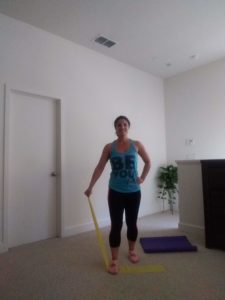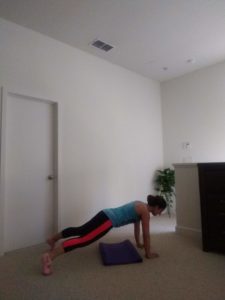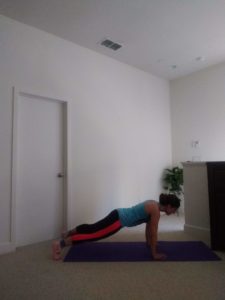Strengthening Exercises for Weak Muscles from Prolonged Sitting
Strengthening Exercises for Weak Muscles from Prolonged Sitting
If you sit for prolonged periods of time in your daily life, regularly performing exercises intended to strengthen muscles that are weakened from this sedentary lifestyle can be beneficial and is recommended!
Muscles that are commonly weakened by prolonged sitting are those of the back, back of shoulders, core, and glutes. Generally speaking, one who regularly sits for long periods of time needs to strengthen the muscles of the back side of the body and stretch the muscles of the front side of the body.
In planning and selecting strengthening exercises, is important to incorporate basic, diverse movements so all exercises aren’t being performed in the same plane of motion. Examples include elements of pushing, pulling, rotating, and moving sideways (laterally), which can help reduce the risk of imbalances.
I’ve put together some exercises to get you started below through my illustrations and descriptions! Keeping simplicity and accessibility in mind for the novice/beginner to resistance training (and perhaps even a regular exercise routine), and to help provide a base to build from, these exercises consist of utilizing body weight and light resistance bands, and can really be done anywhere! (Seriously, anywhere! I traveled around the world with a resistance band and Figure 8 Tubing in my backpack and worked out in a variety of creative places.) In a couple of exercises, I’ve incorporated a Bender Ball or Gliding Discs as options to progress with intensity/challenge.
(Please note: While these exercises are appropriate for the general population, it is advised to consult with your physician with any concerns before beginning any type of exercise program and listen to your own body to avoid pain and/or injury. If you experience any pain, stop immediately.)
Keep these things in mind before you begin:
- Bilateral means both sides at the same time; unilateral means one side at a time. The exercises illustrated and described below that are on one side of the body should be repeated on the other side of the body to promote proper muscle balance.
- Start with performing 8-12 repetitions for each exercise (1 set) and progress with time.
- Exhale on the exertion (hardest work) phase of each exercise (e.g. exhale as you extend the arm at the elbow for triceps extensions, inhale back to your starting position).
- Move at a controlled pace (i.e. not too fast; a count of two for the direction of the exertion, and two for the direction of the release, for exercises where this is applicable, is great to start with).
- As a general modification option, reduce the range of motion of the exercises to make them even more accessible if needed.
- Wear comfortable, breathable clothing. Because these exercises are not weight-bearing, you can perform them barefoot, with socks (I’m wearing my Barre Sox personally in the photos below — I love the grip they have on the bottom), or with athletic shoes (I recommend cross-trainers).
- If you are performing these exercises on carpet, a mat is not necessary but you are welcome to use one if you prefer. If you are going to be working out on a hard surface (e.g. hardwood floor, tile, concrete, etc.), you’ll want to use a mat specifically for the floor exercises, to provide some padding/support (especially when on or above your knees).
- Keep a glass/bottle of water nearby so you can sip on it throughout the workout to stay hydrated.
Exercise #1: Seated High Rows (Bilateral)
*Muscles worked: Upper/mid-back (trapezius, rhomboids), back of shoulders (posterior deltoids), front of upper arms (biceps)*


Exercise #1 (Alternative Option): Reverse Flys (Bilateral)
*Muscles worked: Upper/mid-back (trapezius, rhomboids), back of shoulders (posterior deltoids)*


Exercise #2: Lateral Raises (Unilateral)
*Muscles worked: Middle of shoulders (medial deltoids), upper/mid-back (trapezius)*


Exercise #3: Lat Pull-Downs (Unilateral or Bilateral)
*Muscles worked: Large back muscle (latissimus dorsi), small chest muscle (pectoralis minor), rhomboids, biceps*


Those with shoulder issues where it is not advised (or possible) to raise the arms over the shoulders without pain can perform standing bent-over rows (unilateral).
Exercise #3 (Alternative Option): Bent-Over Rows (Unilateral)
*Muscles worked: Latissimus dorsi, teres major (one of rotator cuff muscles), biceps*



Exercise #4: External Rotation (Unilateral)
*Muscles worked: Rotator cuff (infraspinatus, teres minor)*


Exercise #5: Tricep Kickbacks (Unilateral or Bilateral)
*Muscles worked: Back of upper arms (triceps)*





Exercise #6: Standing Side Crunches (Unilateral)
*Muscles worked: Core/low back (quadratus lumborum — used for spinal lateral flexion)*


Exercise #7: Bicycle Crunches (Unilateral)
*Muscles worked: Core (obliques)*




Exercise #8: Moving Plank (Unilateral or Bilateral)
*Muscles worked: Core stability, maintaining neutral spinal and scapular muscles*






Exercise #9: Bridge (Bilateral)
*Muscles worked: Booty (glutes), upper back of legs (hamstrings), lower back of legs (calves) – (optional with raises)*





Exercise #10: Quadruped/Bird Dog (Unilateral)
*Muscles worked: Core stability, maintaining neutral spinal and scapular muscles*

Exercise #11: Prone Back Extension (Bilateral)
*Muscles worked: Low back (Erector spinae)*


Exercise #11 (Alternaive Option): Superman (Bilateral)
*Muscles worked: Low back (Erector spinae)*

This is not intended to be an exhaustive list/library, as there are so many effective exercises out there to choose from that address all sorts of muscle groups of the body. But I hope this gives you some ideas and education surrounding how to get started in your journey of considering and implementing your own resistance training routine, based on your individual interests, needs, and goals.
For additional information, check out these related resources below:
I purchased my yellow resistance band pictured (equivalent to 6 lbs) online from Resistance Bands Only. It is a resistance band that contains latex (current latex resistance bands on their site are 3-10.2 lbs). They have latex-free resistance bands available with weight equivalent options of 3-11 lbs. They also have ankle resistance bands available with weight equivalent options of 6.6-40 lbs. (Please note: I am not affiliated with RB Only. I have purchased their products for use personally and with my clients.)
Target also sells resistance bands. These latex resistance bands come in a 3-pack of light, medium, and heavy (equivalent to up to 20-50 lbs max). (Please note: I am not affiliated with Target. I have, however, purchased these resistance bands for personal use.)
If you are looking for options to regress (modify or make less intense/challenging) or progress (make more intense/challenging) the exercises I’ve illustrated and explained within this blog post, I’m happy to be a resource!
Cross-training and implementing healthy habits for a balanced, active lifestyle are so important. Check out my Simple Stretching for Wellness blog post to nicely compliment the content in this blog post.
More (relevant) reading material:
Finally, if you want to work with me personally to help you reach your health, fitness, and wellness goals, I offer online personal training services as well as virtual bootcamp program sessions individually and in small groups. (My next Tabata Bootcamp™ Virtual Bootcamp program session starts in January 2019 and registration is open now!)
Feel free to reach out to me anytime with questions or comments at [email protected].
Cheers!
Elena 🙂
My sources: I’ve relied upon my education and experience within the fitness industry to put together this blog post. I hold certifications through the American Council on Exercise (ACE) and the Athletics & Fitness Association of America (AFAA), which are both accredited by the National Commission of Certified Agencies (NCCA). You can learn more about me as a fitness professional here!
I created this blog post as an additional resource that relates to my conversation with Brittany of the BHooked podcast, as she invited me on her show as a featured guest for her 90th episode to talk about Setting Up an Ergonomic and Healthy Lifestyle. I recommend listening to that podcast episode for even more information on workstation ergonomics, stretching and strengthening targeted muscles, and healthy living!
